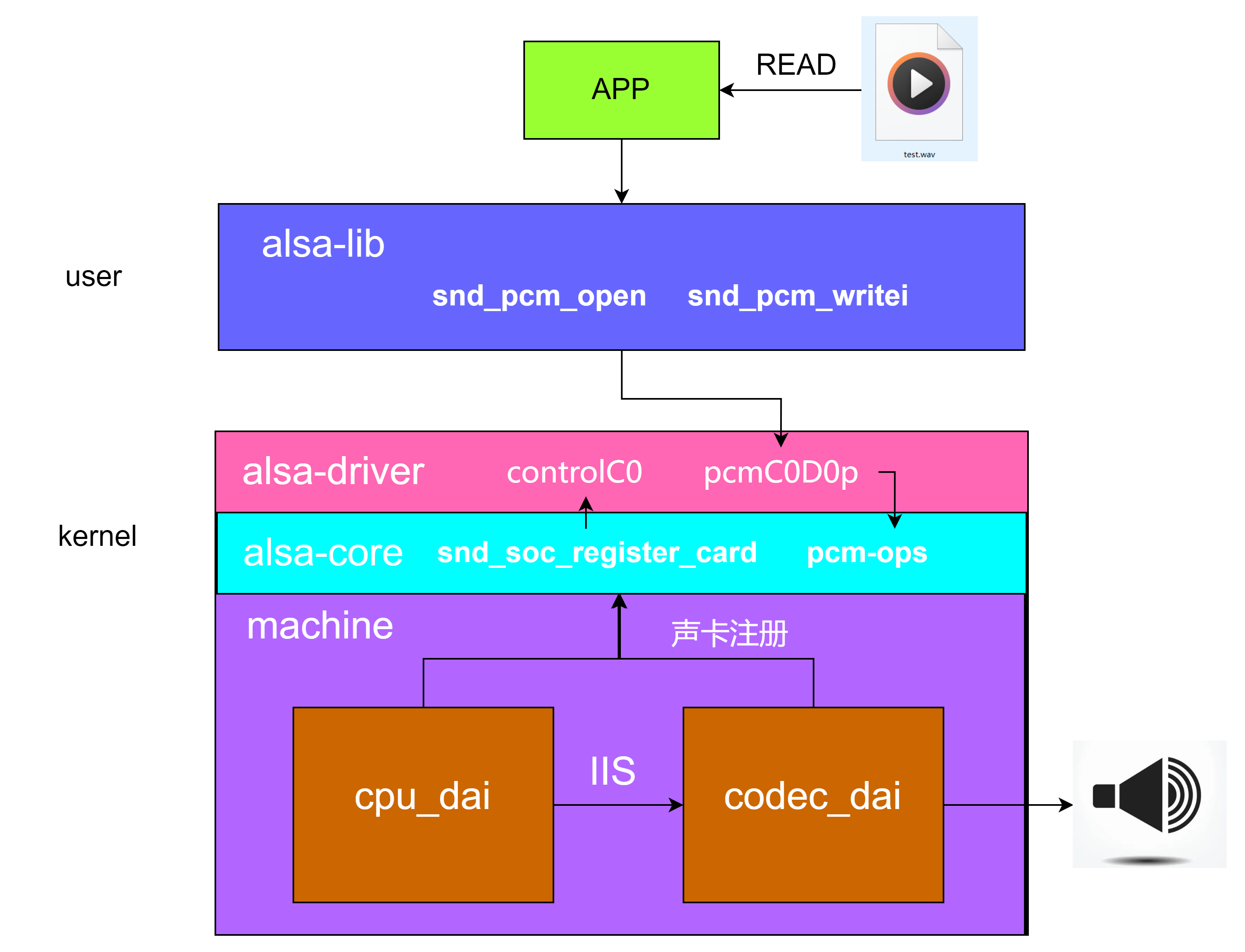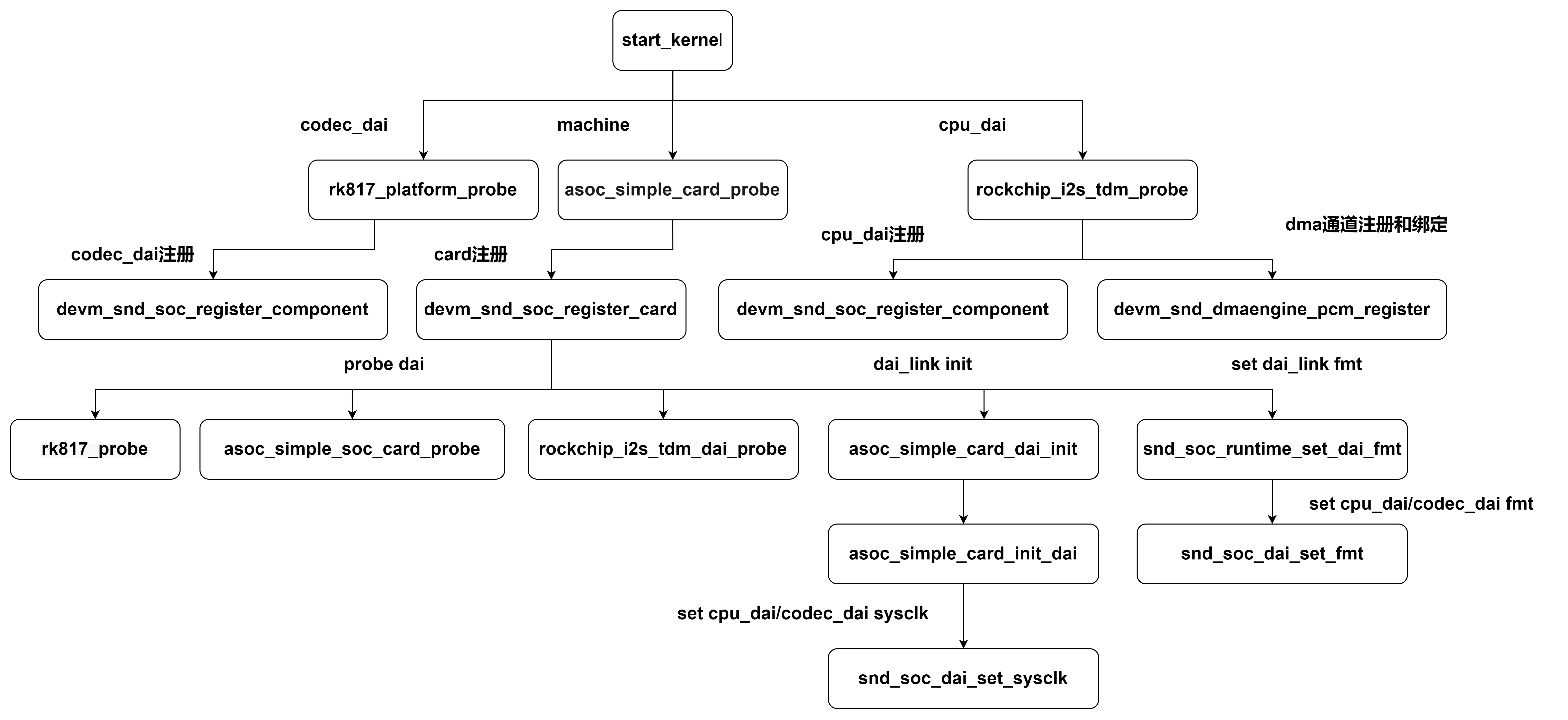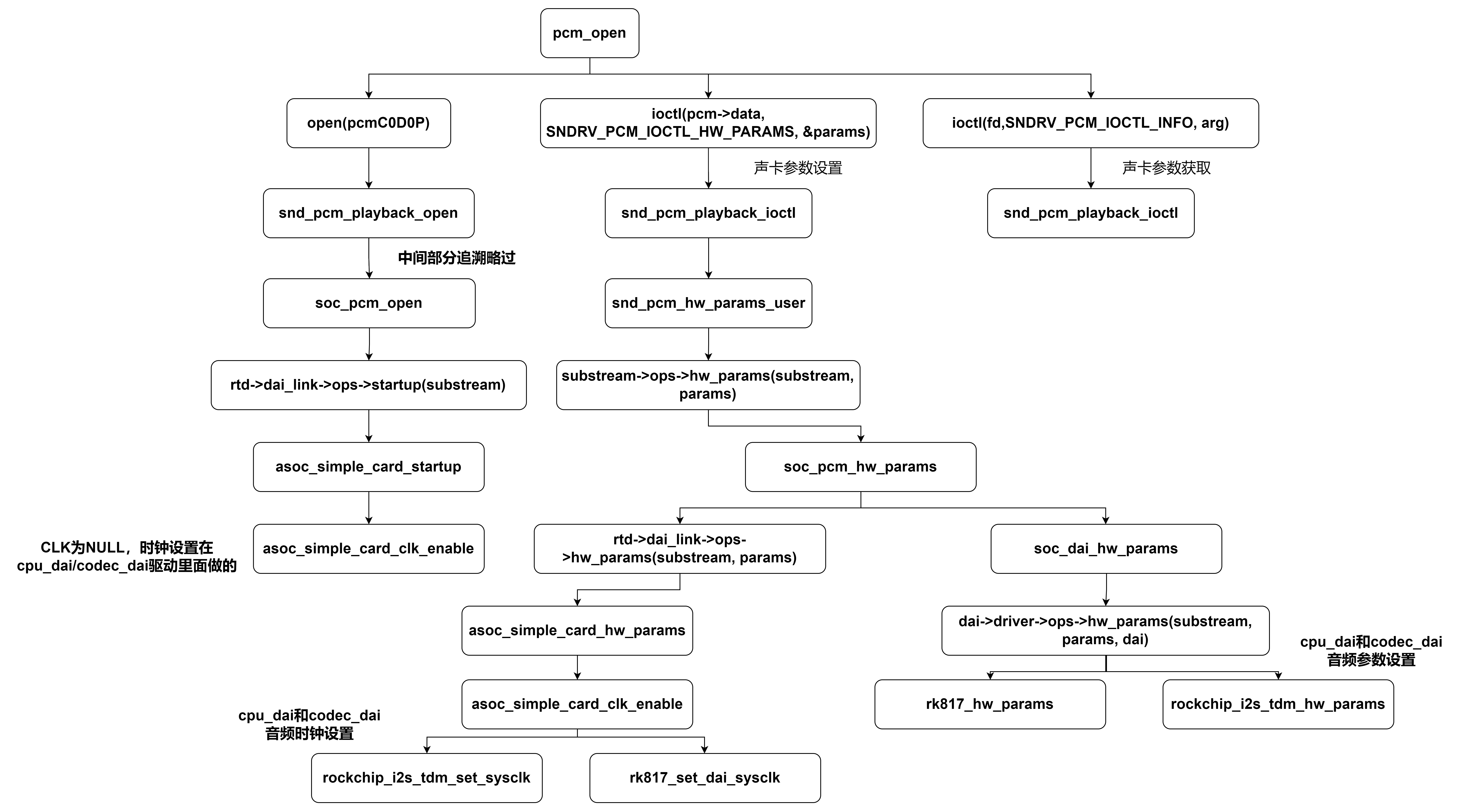一、ALSA驱动框架介绍
1、ALSA介绍
ALSA(Advanced Linux Sound Architecture-高级linux声音架构),目前已经成为了linux的主流音频体系结构,ALSA在内核部分提供alsa-driver对音频驱动进行耦合和管理,在用户空间空间提供alsa-lib,应用开发人员可以使用alsa-lib接口控制声卡。

2、音频播放流程
一个音频文件的播放流程如下图,由dma将音频文件的内容从内存搬运到IIS控制器,后传送到codec音频解码芯片,将数字信号转换为模拟信号输出给耳机或者喇叭

3、alsa设备文件介绍
目录:/dev/snd
controlC0:用于声卡的控制,例如通道选择,混音,麦克风的控制等;
midiC0D0:用于播放midi音频;
pcmC0D0c : 用于录音的pcm设备;
pcmC0D0p :用于播放的pcm设备;
seq :音序器;
timer :定时器;
二、CPU_DAI驱动分析
1、CPU_DAI相关的重要数据,便于对cpu_dai驱动进行理解
struct snd_soc_dai {
const char *name; //描述dai的名称
int id;
struct device *dev;
/* driver ops */
struct snd_soc_dai_driver *driver; //指向snd_soc_dai_driver,这个结构里描述了cpu_dai的支持类型和各种对cpu_dai进行操作的api
/* DAI runtime info */
unsigned int capture_active:1; /* stream is in use */
unsigned int playback_active:1; /* stream is in use */
unsigned int symmetric_rates:1;
unsigned int symmetric_channels:1;
unsigned int symmetric_samplebits:1;
unsigned int active;
unsigned char probed:1;
struct snd_soc_dapm_widget *playback_widget;
struct snd_soc_dapm_widget *capture_widget;
/* DAI DMA data */
void *playback_dma_data; //cpu_dai播放时使用的dma
void *capture_dma_data; //cpu_dai录制时使用的dma
/* Symmetry data - only valid if symmetry is being enforced */
unsigned int rate;
unsigned int channels;
unsigned int sample_bits;
/* parent platform/codec */
struct snd_soc_codec *codec; //指向所关联的codec设备
struct snd_soc_component *component; //指向所关联的component
/* CODEC TDM slot masks and params (for fixup) */
unsigned int tx_mask;
unsigned int rx_mask;
struct list_head list;
};struct snd_soc_dai_driver {
/* DAI description */
const char *name;
unsigned int id;
unsigned int base;
struct snd_soc_dobj dobj;
/* DAI driver callbacks */
int (*probe)(struct snd_soc_dai *dai);
int (*remove)(struct snd_soc_dai *dai);
int (*suspend)(struct snd_soc_dai *dai); //休眠接口
int (*resume)(struct snd_soc_dai *dai); //唤醒接口
/* compress dai */
int (*compress_new)(struct snd_soc_pcm_runtime *rtd, int num);
/* Optional Callback used at pcm creation*/
int (*pcm_new)(struct snd_soc_pcm_runtime *rtd,
struct snd_soc_dai *dai);
/* DAI is also used for the control bus */
bool bus_control;
/* ops */
const struct snd_soc_dai_ops *ops; //对cpu_dai进行操作的api接口集合
const struct snd_soc_cdai_ops *cops;
/* DAI capabilities */
struct snd_soc_pcm_stream capture; //描述播放模式dai支持的参数
struct snd_soc_pcm_stream playback; //描述录制模式dai支持的参数
unsigned int symmetric_rates:1;
unsigned int symmetric_channels:1;
unsigned int symmetric_samplebits:1;
/* probe ordering - for components with runtime dependencies */
int probe_order;
int remove_order;
};
struct snd_soc_dai_ops {
/*
* DAI clocking configuration, all optional.
* Called by soc_card drivers, normally in their hw_params.
*/
//设置时钟
int (*set_sysclk)(struct snd_soc_dai *dai,
int clk_id, unsigned int freq, int dir);
//设置锁相环
int (*set_pll)(struct snd_soc_dai *dai, int pll_id, int source,
unsigned int freq_in, unsigned int freq_out);
//设置时钟分频系数
int (*set_clkdiv)(struct snd_soc_dai *dai, int div_id, int div);
int (*set_bclk_ratio)(struct snd_soc_dai *dai, unsigned int ratio);
/*
* DAI format configuration
* Called by soc_card drivers, normally in their hw_params.
*/
int (*set_fmt)(struct snd_soc_dai *dai, unsigned int fmt);
int (*xlate_tdm_slot_mask)(unsigned int slots,
unsigned int *tx_mask, unsigned int *rx_mask);
int (*set_tdm_slot)(struct snd_soc_dai *dai,
unsigned int tx_mask, unsigned int rx_mask,
int slots, int slot_width);
int (*set_channel_map)(struct snd_soc_dai *dai,
unsigned int tx_num, unsigned int *tx_slot,
unsigned int rx_num, unsigned int *rx_slot);
int (*get_channel_map)(struct snd_soc_dai *dai,
unsigned int *tx_num, unsigned int *tx_slot,
unsigned int *rx_num, unsigned int *rx_slot);
int (*set_tristate)(struct snd_soc_dai *dai, int tristate);
int (*set_sdw_stream)(struct snd_soc_dai *dai,
void *stream, int direction);
/*
* DAI digital mute - optional.
* Called by soc-core to minimise any pops.
*/
int (*digital_mute)(struct snd_soc_dai *dai, int mute);
int (*mute_stream)(struct snd_soc_dai *dai, int mute, int stream);
/*
* ALSA PCM audio operations - all optional.
* Called by soc-core during audio PCM operations.
*/
int (*startup)(struct snd_pcm_substream *,
struct snd_soc_dai *);
void (*shutdown)(struct snd_pcm_substream *,
struct snd_soc_dai *);
int (*hw_params)(struct snd_pcm_substream *,
struct snd_pcm_hw_params *, struct snd_soc_dai *);
int (*hw_free)(struct snd_pcm_substream *,
struct snd_soc_dai *);
int (*prepare)(struct snd_pcm_substream *,
struct snd_soc_dai *);
/*
* NOTE: Commands passed to the trigger function are not necessarily
* compatible with the current state of the dai. For example this
* sequence of commands is possible: START STOP STOP.
* So do not unconditionally use refcounting functions in the trigger
* function, e.g. clk_enable/disable.
*/
int (*trigger)(struct snd_pcm_substream *, int,
struct snd_soc_dai *);
int (*bespoke_trigger)(struct snd_pcm_substream *, int,
struct snd_soc_dai *);
/*
* For hardware based FIFO caused delay reporting.
* Optional.
*/
snd_pcm_sframes_t (*delay)(struct snd_pcm_substream *,
struct snd_soc_dai *);
};
2、DTS-NODE
i2s1_8ch: i2s@fe410000 {
compatible = "rockchip,rk3568-i2s-tdm";
reg = <0x0 0xfe410000 0x0 0x1000>;
interrupts = <GIC_SPI 53 IRQ_TYPE_LEVEL_HIGH>;
clocks = <&cru MCLK_I2S1_8CH_TX>, <&cru MCLK_I2S1_8CH_RX>, <&cru HCLK_I2S1_8CH>;
clock-names = "mclk_tx", "mclk_rx", "hclk";
dmas = <&dmac1 2>, <&dmac1 3>;
dma-names = "tx", "rx";
resets = <&cru SRST_M_I2S1_8CH_TX>, <&cru SRST_M_I2S1_8CH_RX>;
reset-names = "tx-m", "rx-m";
rockchip,cru = <&cru>;
rockchip,grf = <&grf>;
#sound-dai-cells = <0>;
pinctrl-names = "default";
pinctrl-0 = <&i2s1m0_sclktx
&i2s1m0_sclkrx
&i2s1m0_lrcktx
&i2s1m0_lrckrx
&i2s1m0_sdi0
&i2s1m0_sdi1
&i2s1m0_sdi2
&i2s1m0_sdi3
&i2s1m0_sdo0
&i2s1m0_sdo1
&i2s1m0_sdo2
&i2s1m0_sdo3>;
status = "disabled";
};
3、rockchip_i2s_tdm_probe分析
cpu_dai驱动从dts获取到cpu_dai硬件信息后进入static int rockchip_i2s_tdm_probe(struct platform_device *pdev)函数,进行一系列cpu_dai的硬件初始化工作
static int rockchip_i2s_tdm_probe(struct platform_device *pdev)
{
...
//初始化snd_soc_dai_driver结构,dai的支持配置和各种用于控制dai的api接口
rockchip_i2s_tdm_dai_prepare(pdev, &soc_dai);
//从设备树获取bclk_fs值,没有默认64
i2s_tdm->bclk_fs = 64;
if (!of_property_read_u32(node, "rockchip,bclk-fs", &val)) {
if ((val >= 32) && (val % 2 == 0))
i2s_tdm->bclk_fs = val;
}
//从设备树中读取各种初始化cpu_dai相关的设置保存到i2s_tdm,例如I2S的时钟参数等
of_property_read_u32(node, ..., &val);
devm_reset_control_get(&pdev->dev, ...);
devm_clk_get(&pdev->dev, "hclk")
devm_clk_get(&pdev->dev, "mclk_tx");
devm_clk_get(&pdev->dev, "mclk_rx")
//获取cpu_dai的寄存器地址,并初始化cpu_dai
platform_get_resource(pdev, IORESOURCE_MEM, 0);
devm_ioremap_resource(&pdev->dev, res);
//初始化regmap
devm_regmap_init_mmio(&pdev->dev, regs, &rockchip_i2s_tdm_regmap_config);
//TX/RX的dma参数获取
i2s_tdm->playback_dma_data.addr = res->start + I2S_TXDR;
i2s_tdm->playback_dma_data.addr_width = DMA_SLAVE_BUSWIDTH_4_BYTES;
i2s_tdm->playback_dma_data.maxburst = 8;
i2s_tdm->capture_dma_data.addr = res->start + I2S_RXDR;
i2s_tdm->capture_dma_data.addr_width = DMA_SLAVE_BUSWIDTH_4_BYTES;
i2s_tdm->capture_dma_data.maxburst = 8;
//初始化cpu_dai的tx和rx通路
rockchip_i2s_tdm_tx_path_prepare(i2s_tdm, node);
rockchip_i2s_tdm_rx_path_prepare(i2s_tdm, node);
i2s_tdm->soc_data->init(&pdev->dev, res->start);
//注册component组件
devm_snd_soc_register_component(&pdev->dev,
&rockchip_i2s_tdm_component,
soc_dai, 1);
- >snd_soc_register_component(dev, cmpnt_drv, dai_drv, num_dai);
//获取dma
devm_snd_dmaengine_pcm_register(&pdev->dev, NULL, 0);
->snd_soc_add_platform(dev, &pcm->platform,&dmaengine_pcm_platform);
return 0;
}
snd_soc_register_component(dev, cmpnt_drv, dai_drv, num_dai)后续分析
snd_soc_register_component(dev, cmpnt_drv, dai_drv, num_dai)->
snd_soc_component_initialize(cmpnt, cmpnt_drv, dev); //初始化component
//注册了一个dai,并填充snd_soc_dai_driver数据
snd_soc_register_dais(cmpnt, dai_drv, num_dai, true);
//将component加入component_list链表
snd_soc_component_add(cmpnt);
该函数被传入两个关键参数struct snd_soc_component_driver cmpnt_drv、struct snd_soc_dai_driver dai_drv,定义如下
static const struct snd_soc_component_driver rockchip_i2s_component = {
.name = DRV_NAME,
};
struct snd_soc_dai_driver rockchip_i2s_tdm_dai = {
.probe = rockchip_i2s_tdm_dai_probe,
.playback = {
.stream_name = "Playback",
.channels_min = 2,
.channels_max = 16,
.rates = SNDRV_PCM_RATE_8000_192000,
.formats = (SNDRV_PCM_FMTBIT_S8 |
SNDRV_PCM_FMTBIT_S16_LE |
SNDRV_PCM_FMTBIT_S20_3LE |
SNDRV_PCM_FMTBIT_S24_LE |
SNDRV_PCM_FMTBIT_S32_LE),
},
.capture = {
.stream_name = "Capture",
.channels_min = 2,
.channels_max = 16,
.rates = SNDRV_PCM_RATE_8000_192000,
.formats = (SNDRV_PCM_FMTBIT_S8 |
SNDRV_PCM_FMTBIT_S16_LE |
SNDRV_PCM_FMTBIT_S20_3LE |
SNDRV_PCM_FMTBIT_S24_LE |
SNDRV_PCM_FMTBIT_S32_LE),
},
//对cpu_dai的api操作集合,如dai的时钟配置、格式配置等
.ops = &rockchip_i2s_tdm_dai_ops,
};
snd_soc_add_platform(dev, &pcm->platform,&dmaengine_pcm_platform)后续分析
dmaengine_pcm_request_chan_of(pcm, dev, config);
//根据name去dts中找资源,申请对应的DMA通道
chan = dma_request_slave_channel_reason(dev, name);
return of_dma_request_slave_channel(dev->of_node, name);
//注册platform到ASoC Core
ret = snd_soc_add_platform(dev, &pcm->platform,&dmaengine_pcm_platform);
platform中需要完成音频数据管理和音频数据的dma搬运,其中就涉及到了dma相关的操作,snd_soc_add_platform的目的就是完成dma通道的申请,并将pcm和dma关联起来
三、CODEC驱动分析
1、CODEC相关的重要数据
static const struct regmap_config rk817_codec_regmap_config = {
.name = "rk817-codec",
.reg_bits = 8, //寄存器地址位数(必选项)
.val_bits = 8, //寄存器值位数(必选项)
.reg_stride = 1,
.max_register = 0x4f, //最大寄存器值
.cache_type = REGCACHE_FLAT,
.volatile_reg = rk817_volatile_register,
.writeable_reg = rk817_codec_register, //寄存器是否可写
.readable_reg = rk817_codec_register, //寄存器是否可写读
.reg_defaults = rk817_reg_defaults, //默认寄存器配置参数
.num_reg_defaults = ARRAY_SIZE(rk817_reg_defaults),
};
2、DTS-NODE
rk809_codec: codec {
#sound-dai-cells = <0>;
compatible = "rockchip,rk809-codec", "rockchip,rk817-codec";
clocks = <&cru I2S1_MCLKOUT>;
clock-names = "mclk";
assigned-clocks = <&cru I2S1_MCLKOUT>, <&cru I2S1_MCLK_TX_IOE>;
assigned-clock-rates = <12288000>;
assigned-clock-parents = <&cru I2S1_MCLKOUT_TX>, <&cru I2S1_MCLKOUT_TX>;
pinctrl-names = "default","spk_gpio";
pinctrl-0 = <&i2s1m0_mclk>;
pinctrl-1 = <&spk_ctl_gpio>;
hp-volume = <20>;
spk-volume = <3>;
//mic-in-differential;
capture-volume = <0>;
io-channels = <&saradc 4>;
hp-det-adc-value = <1000>;
spk-ctl-gpios = <&gpio3 RK_PC5 GPIO_ACTIVE_HIGH>;
status = "okay";
};
3、rk817_platform_probe分析
codec_dai驱动从dts获取到硬件信息后进入static int rk817_platform_probe(struct platform_device *pdev)函数,进行一系列codec_dai的硬件初始化工作
static int rk817_platform_probe(struct platform_device *pdev)
{
...
rk817_codec_data = devm_kzalloc(&pdev->dev,sizeof(struct rk817_codec_priv),
GFP_KERNEL); //给rk817_codec_data申请空间
platform_set_drvdata(pdev, rk817_codec_data); //rk817_codec_data绑定pdev
//从dts节点中获取adc通道、gpio节点、volume值等
rk817_codec_parse_dt_property(&pdev->dev, rk817_codec_data);
//regmap初始化
rk817_codec_data->regmap = devm_regmap_init_i2c(rk817->i2c,
&rk817_codec_regmap_config);
//mclk获取
rk817_codec_data->mclk = devm_clk_get(&pdev->dev, "mclk");
//componen注册
devm_snd_soc_register_component(&pdev->dev, &soc_codec_dev_rk817,
rk817_dai, ARRAY_SIZE(rk817_dai));
...
}
devm_snd_soc_register_component后续分析:初始化snd_soc_component的实例,然后注册dai,最终将注册的dai放入component->dai_list中,然后将分配的component放入到component_list链表中,遍历全局的component链表可以找到cpu_dai,codec_dai
devm_snd_soc_register_component->
snd_soc_register_component->
snd_soc_add_component->
snd_soc_component_initialize //component初始化
snd_soc_register_dais //dai注册
snd_soc_component_add //component加入全局链表四、MACHINE(simple-card.c)驱动分析
1、MACHINE相关的重要数据
struct snd_soc_dai_link {
/* config - must be set by machine driver */
const char *name; /* Codec name */
const char *stream_name; /* Stream name */
/*
* You MAY specify the link's CPU-side device, either by device name,
* or by DT/OF node, but not both. If this information is omitted,
* the CPU-side DAI is matched using .cpu_dai_name only, which hence
* must be globally unique. These fields are currently typically used
* only for codec to codec links, or systems using device tree.
*/
const char *cpu_name;
struct device_node *cpu_of_node;
/*
* You MAY specify the DAI name of the CPU DAI. If this information is
* omitted, the CPU-side DAI is matched using .cpu_name/.cpu_of_node
* only, which only works well when that device exposes a single DAI.
*/
const char *cpu_dai_name;
/*
* You MUST specify the link's codec, either by device name, or by
* DT/OF node, but not both.
*/
const char *codec_name;
struct device_node *codec_of_node;
/* You MUST specify the DAI name within the codec */
const char *codec_dai_name;
struct snd_soc_dai_link_component *codecs;
unsigned int num_codecs;
/*
* You MAY specify the link's platform/PCM/DMA driver, either by
* device name, or by DT/OF node, but not both. Some forms of link
* do not need a platform.
*/
const char *platform_name;
struct device_node *platform_of_node;
int id; /* optional ID for machine driver link identification */
const struct snd_soc_pcm_stream *params;
unsigned int num_params;
unsigned int dai_fmt; /* format to set on init */
enum snd_soc_dpcm_trigger trigger[2]; /* trigger type for DPCM */
/* codec/machine specific init - e.g. add machine controls */
int (*init)(struct snd_soc_pcm_runtime *rtd);
/* optional hw_params re-writing for BE and FE sync */
int (*be_hw_params_fixup)(struct snd_soc_pcm_runtime *rtd,
struct snd_pcm_hw_params *params);
/* machine stream operations */
const struct snd_soc_ops *ops;
const struct snd_soc_compr_ops *compr_ops;
/* Mark this pcm with non atomic ops */
bool nonatomic;
/* For unidirectional dai links */
unsigned int playback_only:1;
unsigned int capture_only:1;
/* Keep DAI active over suspend */
unsigned int ignore_suspend:1;
/* Symmetry requirements */
unsigned int symmetric_rates:1;
unsigned int symmetric_channels:1;
unsigned int symmetric_samplebits:1;
/* Do not create a PCM for this DAI link (Backend link) */
unsigned int no_pcm:1;
/* This DAI link can route to other DAI links at runtime (Frontend)*/
unsigned int dynamic:1;
/* This DAI link can be reconfigured at runtime (Backend) */
unsigned int dynamic_be:1;
/*
* This DAI can support no host IO (no pcm data is
* copied to from host)
*/
unsigned int no_host_mode:2;
/* DPCM capture and Playback support */
unsigned int dpcm_capture:1;
unsigned int dpcm_playback:1;
/* DPCM used FE & BE merged format */
unsigned int dpcm_merged_format:1;
/* DPCM used FE & BE merged channel */
unsigned int dpcm_merged_chan:1;
/* DPCM used FE & BE merged rate */
unsigned int dpcm_merged_rate:1;
/* pmdown_time is ignored at stop */
unsigned int ignore_pmdown_time:1;
/* Do not create a PCM for this DAI link (Backend link) */
unsigned int ignore:1;
struct list_head list; /* DAI link list of the soc card */
struct snd_soc_dobj dobj; /* For topology */
/* this value determines what all ops can be started asynchronously */
enum snd_soc_async_ops async_ops;
};
struct snd_soc_card {
const char *name;
const char *long_name;
const char *driver_name;
char dmi_longname[80];
char topology_shortname[32];
struct device *dev;
struct snd_card *snd_card;
struct module *owner;
struct mutex mutex;
struct mutex dapm_mutex;
struct mutex dapm_power_mutex;
bool instantiated;
bool topology_shortname_created;
int (*probe)(struct snd_soc_card *card);
int (*late_probe)(struct snd_soc_card *card);
int (*remove)(struct snd_soc_card *card);
/* the pre and post PM functions are used to do any PM work before and
* after the codec and DAI's do any PM work. */
int (*suspend_pre)(struct snd_soc_card *card);
int (*suspend_post)(struct snd_soc_card *card);
int (*resume_pre)(struct snd_soc_card *card);
int (*resume_post)(struct snd_soc_card *card);
/* callbacks */
int (*set_bias_level)(struct snd_soc_card *,
struct snd_soc_dapm_context *dapm,
enum snd_soc_bias_level level);
int (*set_bias_level_post)(struct snd_soc_card *,
struct snd_soc_dapm_context *dapm,
enum snd_soc_bias_level level);
int (*add_dai_link)(struct snd_soc_card *,
struct snd_soc_dai_link *link);
void (*remove_dai_link)(struct snd_soc_card *,
struct snd_soc_dai_link *link);
long pmdown_time;
/* CPU <--> Codec DAI links */
struct snd_soc_dai_link *dai_link; /* predefined links only */
int num_links; /* predefined links only */
struct list_head dai_link_list; /* all links */
int num_dai_links;
struct list_head rtd_list;
int num_rtd;
/* optional codec specific configuration */
struct snd_soc_codec_conf *codec_conf;
int num_configs;
/*
* optional auxiliary devices such as amplifiers or codecs with DAI
* link unused
*/
struct snd_soc_aux_dev *aux_dev;
int num_aux_devs;
struct list_head aux_comp_list;
const struct snd_kcontrol_new *controls;
int num_controls;
/*
* Card-specific routes and widgets.
* Note: of_dapm_xxx for Device Tree; Otherwise for driver build-in.
*/
const struct snd_soc_dapm_widget *dapm_widgets;
int num_dapm_widgets;
const struct snd_soc_dapm_route *dapm_routes;
int num_dapm_routes;
const struct snd_soc_dapm_widget *of_dapm_widgets;
int num_of_dapm_widgets;
const struct snd_soc_dapm_route *of_dapm_routes;
int num_of_dapm_routes;
bool fully_routed;
struct work_struct deferred_resume_work;
/* lists of probed devices belonging to this card */
struct list_head component_dev_list;
struct list_head widgets;
struct list_head paths;
struct list_head dapm_list;
struct list_head dapm_dirty;
/* attached dynamic objects */
struct list_head dobj_list;
/* Generic DAPM context for the card */
struct snd_soc_dapm_context dapm;
struct snd_soc_dapm_stats dapm_stats;
struct snd_soc_dapm_update *update;
#ifdef CONFIG_DEBUG_FS
struct dentry *debugfs_card_root;
struct dentry *debugfs_pop_time;
#endif
u32 pop_time;
void *drvdata;
};
2、DTS-NODE
rk809_sound: rk809-sound {
status = "okay";
compatible = "simple-audio-card";
simple-audio-card,format = "i2s";
simple-audio-card,name = "rockchip,rk809-codec";
simple-audio-card,mclk-fs = <256>;
simple-audio-card,widgets =
"Microphone", "Mic Jack",
"Headphone", "Headphone Jack";
simple-audio-card,routing =
"Mic Jack", "MICBIAS1",
"IN1P", "Mic Jack",
"Headphone Jack", "HPOL",
"Headphone Jack", "HPOR";
simple-audio-card,cpu {
sound-dai = <&i2s1_8ch>;
};
simple-audio-card,codec {
sound-dai = <&rk809_codec>;
};
};
3、asoc_simple_card_probe分析
codec_dai驱动从dts获取到cpu_dai和codec_dai的连接关系和节点后,进入asoc_simple_card_probe,进行声卡的注册和初始化工作
static int asoc_simple_card_probe(struct platform_device *pdev)
{
struct snd_soc_dai_link *dai_link;
struct snd_soc_card *card;
...
//初始化snd_soc_card
card = simple_priv_to_card(priv);
card->owner = THIS_MODULE;
card->dev = dev;
card->dai_link = priv->dai_link;
card->num_links = num;
card->probe = asoc_simple_soc_card_probe;
//从DTS中获取cpu_dai\codec_dai节点、widgets、routing等信息,填充snd_soc_dai_link
asoc_simple_card_parse_of(priv);->
asoc_simple_card_of_parse_widgets(card, PREFIX);
asoc_simple_card_of_parse_routing(card, PREFIX, 1);
asoc_simple_card_dai_link_of(node, priv, 0, true);
//实例化和填充card,绑定dailink,创建音频节点pcmC0D0P,并完成cpu_dai和codec的probe
devm_snd_soc_register_card(dev, card);
snd_soc_register_card(card);->
snd_soc_instantiate_card(card);
...
}
devm_snd_soc_register_card(dev, card)的分析流程如下:
devm_snd_soc_register_card(dev, card);
snd_soc_register_card(card);->
snd_soc_instantiate_card(card); ->
soc_bind_dai_link(card, &card->dai_link[i]);
snd_card_new(card->dev, SNDRV_DEFAULT_IDX1, SNDRV_DEFAULT_STR1,card->owner, 0, &card->snd_card); //绑定完成后申请一个声卡
card->probe(card); //仅初始化一次声卡
soc_probe_link_components(card, rtd, order); //probe 该声卡dai_link上的所有components组件
soc_probe_link_dais(card, rtd, order); //probe 该声卡所有dai_link->
//建立playback stream/capture stream,相应的substream也同时建立,ops绑定snd_pcm_dev_register,回调函数会在声卡的 注册阶段被调用
soc_new_pcm(rtd, num);
// 设置操作该pcm的控制/操作接口函数
snd_pcm_set_ops(pcm, SNDRV_PCM_STREAM_PLAYBACK, &rtd->ops);
snd_card_register(card->snd_card); //注册声卡,遍历声卡下的所有逻辑设备,调用各设备的注册回调函数,对于pcm,就是上面提到的snd_pcm_dev_register函数,该回调函数建立了和用户空间应用程序(alsa-lib)通信所用的设备文件节点:/dev/snd/pcmCxxDxxp 和 /dev/snd/pcmCxxDxxc
五、ALSA-Probe的流程
下图是板子内核启动到probe完成阶段的流程图,可以看到ALSA初始化音频的整个流程是怎么初始化声卡,和配置一些基本参数的

六、Tinyalsa pcm_open的调用流程
先看下pcm的fops,接口如下,定义在pcm_native.c
const struct file_operations snd_pcm_f_ops[2] = {
{
.owner = THIS_MODULE,
.write = snd_pcm_write,
.write_iter = snd_pcm_writev,
.open = snd_pcm_playback_open,
.release = snd_pcm_release,
.llseek = no_llseek,
.poll = snd_pcm_playback_poll,
.unlocked_ioctl = snd_pcm_playback_ioctl,
.compat_ioctl = snd_pcm_ioctl_compat,
.mmap = snd_pcm_mmap,
.fasync = snd_pcm_fasync,
.get_unmapped_area = snd_pcm_get_unmapped_area,
},
{
.owner = THIS_MODULE,
.read = snd_pcm_read,
.read_iter = snd_pcm_readv,
.open = snd_pcm_capture_open,
.release = snd_pcm_release,
.llseek = no_llseek,
.poll = snd_pcm_capture_poll,
.unlocked_ioctl = snd_pcm_capture_ioctl,
.compat_ioctl = snd_pcm_ioctl_compat,
.mmap = snd_pcm_mmap,
.fasync = snd_pcm_fasync,
.get_unmapped_area = snd_pcm_get_unmapped_area,
}
};
substream是pcm ops的下一层,绝大部分任务都是在substream中处理,substream的ops定义在soc-pcm.c,定义如下
int soc_new_pcm(struct snd_soc_pcm_runtime *rtd, int num)
{
...
/* ASoC PCM operations */
if (rtd->dai_link->dynamic) {
rtd->ops.open = dpcm_fe_dai_open;
rtd->ops.hw_params = dpcm_fe_dai_hw_params;
rtd->ops.prepare = dpcm_fe_dai_prepare;
rtd->ops.trigger = dpcm_fe_dai_trigger;
rtd->ops.hw_free = dpcm_fe_dai_hw_free;
rtd->ops.close = dpcm_fe_dai_close;
rtd->ops.pointer = soc_pcm_pointer;
rtd->ops.ioctl = soc_pcm_ioctl;
} else {
rtd->ops.open = soc_pcm_open;
rtd->ops.hw_params = soc_pcm_hw_params;
rtd->ops.prepare = soc_pcm_prepare;
rtd->ops.trigger = soc_pcm_trigger;
rtd->ops.hw_free = soc_pcm_hw_free;
rtd->ops.close = soc_pcm_close;
rtd->ops.pointer = soc_pcm_pointer;
rtd->ops.ioctl = soc_pcm_ioctl;
}
...
if (playback)
snd_pcm_set_ops(pcm, SNDRV_PCM_STREAM_PLAYBACK, &rtd->ops);
if (capture)
snd_pcm_set_ops(pcm, SNDRV_PCM_STREAM_CAPTURE, &rtd->ops);
...
}
下图使用tinyalsa测试,可以看到alsa-driver在pcm_open阶段做了哪些工作,流程是什么

七、Tinyalsa pcm_write的调用流程
下图使用tinyalsa测试,可以看到alsa-driver在pcm_write阶段做了哪些工作,流程是什么

至此整个ALSA-DRIVER框架的内容就分析完了,可能有一些细节的东西内容太多导致没法去描述,有需求的话,可以自行根据需求分析